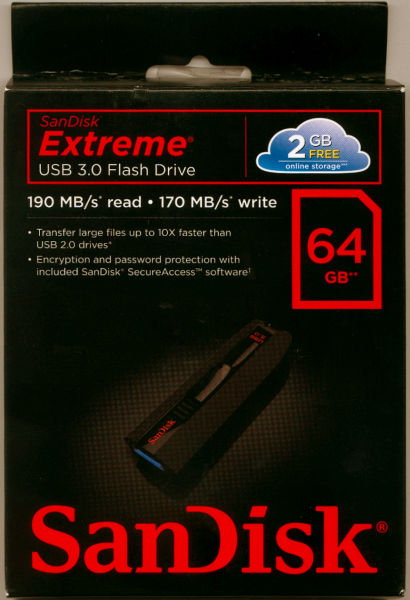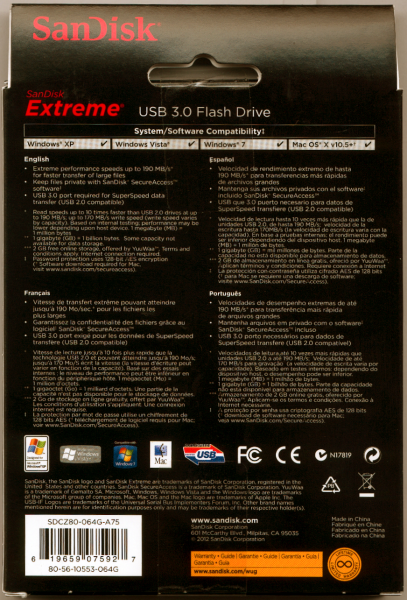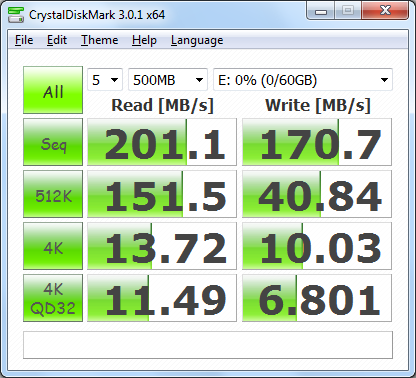

Model: SanDisk Extreme USB 3.0 Flash Drive
Manufacturer: SanDisk
Provided By: SanDisk
SanDisk has been a leader in the storage industry for more than 20 years. Founded in 1988 by Dr. Eli Harari, the company has grown to become the world's largest supplier of flash memory data storage products. The company offers a wide range of products including memory cards, USB flash drives, SSDs and its popular line of Sansa music and video players.
This spring SanDisk launched its first USB 3.0 flash drive, the Extreme. Available in 16GB, 32GB and 64GB capacities, this new flash drive sports a compact, slim design and is capable of delivering up to 190MB/s sequential read and 170MB/s sequential write speeds. The Extreme also ships with SanDisk's SecureAccess software, which protects files against unauthorized access by creating an encrypted, password-protected folder, or "vault," on the drive. To top it all off, the Extreme is compatible with Windows XP/Vista/7 as well as Mac OS X and is backed by a lifetime limited warranty.
| SanDisk Extreme USB 3.0 Flash Drive | |||||||||||||||
General Specifications
Performance
Environmental
Other Features
|
Needless to say, this is only a taste of what the Extreme has to offer. To give you an idea of what to expect, we'll take a closer look at SanDisk's new USB 3.0 flash drive and then see how well it performs. Does the Extreme live up to its name? Keep reading as we find out.
Packaging:
SanDisk's Extreme USB 3.0 flash drive comes in a small, black box. Along with a picture of the drive, the front advertises many of its key features including its capacity, rated speeds, password protection and 2GB of free online storage. The back of the box provides a bit more information regarding the Extreme's features, capabilities and supported operating systems.
Physical Features:
While far from being the smallest flash drive in SanDisk's lineup, the Extreme is relatively compact for a USB 3.0 flash drive. With the USB connector retracted, the drive measures 2.79" (70.87mm) long, 0.84" (21.34mm) wide and 0.45" (11.43mm) thick.

The body of the Extreme is constructed of a lightweight, black plastic. While the strip in the middle has a glossy finish, the sides and bottom have a rougher, matte finish which makes it a little easier to hang onto the drive. The Extreme also has a hole on the end so that it can be attached to your key ring.

The Extreme's USB connector is exposed using a sliding mechanism that can be manipulated with your thumb. This sliding mechanism is spring assisted and is one of the smoothest I have seen. There is also a LED underneath the mechanism which lights up blue whenever the drive is transmitting or receiving data or is in the identification process.
Installation:
As with most USB flash drives, the SanDisk Extreme was very easy to install. Those running Windows XP, Vista or 7 can simply plug the drive into any available USB 2.0 or 3.0 port on their computer. If the computer is already turned on, plug and play will automatically detect the drive.

If installed correctly, the Extreme should show up in the Device Manager. Under Windows 7, the drive is identified as a "SanDisk Extreme USB Device".

The Extreme comes formatted with FAT32, giving the 64GB model about 59.5GB of usable space. Of that, about 64MB is taken up by the SecureAccess software that comes bundled with the drive.
Software:
The SanDisk Extreme ships with the company's SecureAccess software. Available for both Windows and Mac, SecureAccess is a fast and easy way to protect sensitive files on any SanDisk USB flash drive. The software automatically secures files using 128-bit AES encryption and then stores them in a password-protected folder or “vault" on the drive.
Before you can protect files using SecureAccess, you will need to create your own vault. To begin, connect the SanDisk Extreme to your computer and double-click the RunSanDiskSecureAccess.exe file. When the program launches, select your preferred language and enter a personal password for the vault. The password must be at least 6 characters and contain both numeric and alphabet characters.
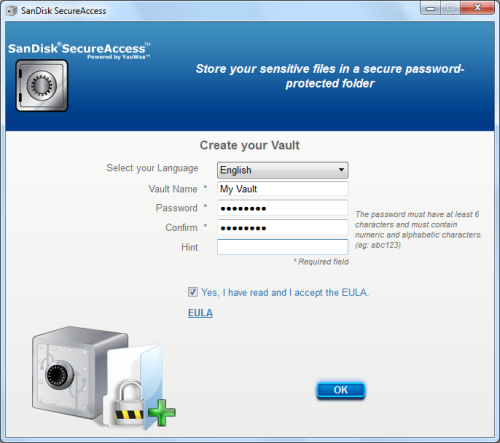
This screen also gives you the option to install SecureAccess Manager on your computer. While this isn't required, it will automatically launch SecureAccess when you plug in your drive.

Files and folders can be moved into your vault by dragging and dropping them onto the main screen or the vault icon. They can also be copied and pasted onto the main screen or added manually using the "Add Files" button.
SanDisk SecureAccess also includes support for YuuWaa's online backup service. To use this feature, create a YuuWaa account and select which folders and file types you want to backup. Once backed up, your files can be accessed from any computer using a web browser.

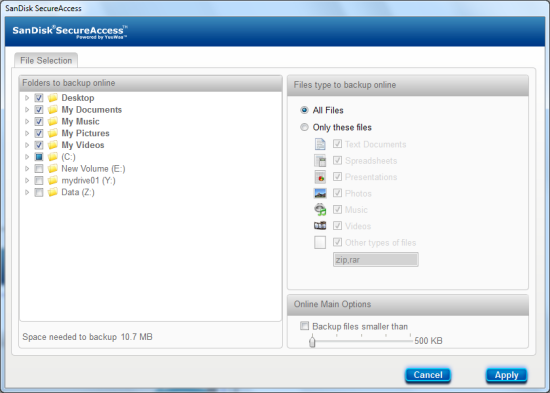
YuuWaa lets you store up to 2GB of data for free. If you need more, you can buy a yearly service plan which includes additional storage. Prices range from $24.99 for 10GB up to $239.99 for 200GB of storage, which is a considerable increase from when we reviewed SanDisk's Ultra USB flash drive a year or so ago.
Performance:
The test system used in this review was an HP 8200 Elite. The computer is equipped with an Intel Core i5-2400 CPU, 4GB of DDR3 1333MHz memory, Seagate Barracuda 7200.12 ST3250312AS 250GB SATA 6 Gb/s hard drive, NVIDIA Quadro FX580 512MB PCIe graphics card, Intel 82567LM-3 gigabit network card and Patriot SuperSpeed USB PCIe host card. For the operating system, I installed a fresh copy of Windows 7 Enterprise.
To test the performance of the SanDisk Extreme, I ran a series of benchmarks using CrystalDiskMark 3.0.1, HD Tach RW 3.0.4.0, ATTO Disk Benchmark 2.46 and SiSoftware Sandra Lite 2012.SP4c. To get a feel for the "real world" performance, I also copied and pasted 500MB of random files and directories in Windows Explorer.
CrystalDiskMark 3.0:
First, I ran a few quick tests using CrystalDiskMark. This benchmark tool measures the performance of a storage device by testing its sequential read and write speeds as well as its random read and write speeds using blocks 512K and 4K in size.
According to SanDisk, the Extreme USB 3.0 is capable of reading at 190MB/s and writing at 170MB/s when connected to a USB 3.0 port. Looking at the screenshots above, you can see that the drive had no problems reaching these numbers in CrystalDiskMark's sequential read and write speed tests.
HD Tach RW 3.0.4.0:
Next, I used HD Tach to test the Extreme's read, write and burst speeds as well as its seek times and CPU usage.

When connected to the computer's USB 3.0 port, the Extreme had average read and write speeds of 184.8 MB/s and 138.4 MB/s, respectively, as well as a burst speed of 173.3 MB/s. As you'd expect, the drive wasn't nearly as fast when using USB 2.0. Compared to what we saw with USB 3.0, the Extreme's read speed dropped by more than 150 MB/s.
ATTO Disk Benchmark 2.46:
I also used ATTO Disk Benchmark to test the Extreme's sequential read and write speeds. The test was run using blocks ranging in size from 0.5KB to 8192KB and the total length set to 256MB.
When tested with ATTO, the Extreme's read speeds topped out at about 205 MB/s and its write speeds at 159 MB/s.
SiSoft Sandra File System Benchmark:
While I am not a big fan of SiSoftware Sandra's optical drive benchmarks, it is a great tool if you want to test a system's performance quickly and easily. One of Sandra's more useful tests is the File System benchmark. This benchmark gives each drive an overall score, or "Drive Index," based on the results of its read and write tests.
| SanDisk Extreme USB 3.0 |
Kingston DT HyperX 3.0 |
Patriot Supersonic | Kingston DT Ultimate 3.0 G2 | |
| Drive Index: | 162.00 MB/s | 159.50 MB/s | 101.89 MB/s | 102.84 MB/s |
| Buffered Read: | 89.61 MB/s | 71.14 MB/s | 47.84 MB/s | 47.00 MB/s |
| Sequential Read: | 186.12 MB/s | 205.84 MB/s | 124.10 MB/s | 124.22 MB/s |
| Random Read: | 160.62 MB/s | 161.00 MB/s | 108.58 MB/s | 108.77 MB/s |
| Buffered Write: | 29.74 MB/s | 9.40 MB/s | 14.50 MB/s | 15.00 MB/s |
| Sequential Write: | 164.44 MB/s | 75.7 MB/s | 62.00 MB/s | 68.74 MB/s |
| Random Write: | 47.38 MB/s | 1.47 MB/s | 2.00 MB/s | 2.00 MB/s |
SiSoftware Sandra Removable Storage/Flash Devices Benchmark:
Designed with removable storage and flash devices in mind, this benchmark tests a drive's read, write and delete performance using six different file sizes (4kB, 64kB, 1MB, 16MB and 256MB). The results are then given in both operations per minute and the corresponding net transfer rate in MB/second. This benchmark also computes an "Endurance Factor," representing the wear and life expectancy of flash devices.

| SanDisk Extreme USB 3.0 |
Kingston DT HyperX 3.0 |
Patriot Supersonic | Kingston DT Ultimate 3.0 G2 | |
| 4kB Read: | 9.56 MB/s | 10.53 MB/s | 6.74 MB/s | 3.90 MB/s |
| 64kB Read: | 105.33 MB/s | 80.25 MB/s | 57.00 MB/s | 41.55 MB/s |
| 1MB Read: | 162.80 MB/s | 143.78 MB/s | 92.40 MB/s | 66.76 MB/s |
| 16MB Read: | 158.17 MB/s | 168.00 MB/s | 93.00 MB/s | 100.56 MB/s |
| 256MB Read: | 180.16 MB/s | 195.40 MB/s | 104.13 MB/s | 111.00 MB/s |
The Extreme had no problems taking the top spot in this test. The drive took off like a rocket, eventually reaching 195.4 MB/s when reading 256MB files.

| SanDisk Extreme USB 3.0 |
Kingston DT HyperX 3.0 |
Patriot Supersonic | Kingston DT Ultimate 3.0 G2 | |
| 4kB Write: | 7.28 MB/s | 0.209 MB/s | 0.238 MB/s | 0.210 MB/s |
| 64kB Write: | 25.13 MB/s | 3.00 MB/s | 3.48 MB/s | 3.00 MB/s |
| 1MB Write: | 72.00 MB/s | 31.87 MB/s | 22.71 MB/s | 15.74 MB/s |
| 16MB Write: | 34.34 MB/s | 21.00 MB/s | 19.87 MB/s | 30.56 MB/s |
| 256MB Write: | 156.57 MB/s | 42.00 MB/s | 32.48 MB/s | 34.53 MB/s |
The Extreme also performed fairly well when writing. While there were a few cases where it lagged behind the Supersonic, it had a clear advantage when writing larger files.

| SanDisk Extreme USB 3.0 |
Kingston DT HyperX 3.0 |
Patriot Supersonic | Kingston DT Ultimate 3.0 G2 | |
| Combined Index: | 1600 | 1168.4 | 776.9 | 486.2 |
| 4kB Files Test: | 2200 | 1769.7 | 1141.0 | 666.6 |
| 64kB Files Test: | 1200 | 851.6 | 612.9 | 448.7 |
| 1MB Files Test: | 134 | 104.6 | 68.8 | 48.9 |
| 16MB Files Test: | 7 | 7.3 | 4.3 | 4.8 |
| 256MB Files Test: | 0.67 | 0.60 | 0.40 | 0.30 |
As I mentioned above, Sandra also expresses performance in operations per minute. To keep things simple, I've limited the results to the combined index and the total number of read/write/delete operations for each file size. I should also point out that the latest version of Sandra rounds off the number of IOPS to the nearest hundred when it gets above 1000.
| SanDisk Extreme USB 3.0 |
Kingston DT HyperX 3.0 |
Patriot Supersonic | Kingston DT Ultimate 3.0 G2 | |
| Endurance Factor: | 1.80 | 1.50 | 1.10 | 1.30 |
The Endurance Factor represents the wear and life expectancy of a flash device. According to SiSoft, this number is computed by "dividing the average performance (normal condition, i.e. sequential write) to the lowest performance (high-stress condition, i.e. same block re-write)."
"Real World" Benchmark:
To test the "real world" performance of SanDisk's new flash drive, I copied and pasted 500 MB worth of randomly generated files and directories. All of the files are between 10 bytes and 32MB in size and no more than four directories deep.
| SanDisk Extreme USB 3.0 |
Kingston DT HyperX 3.0 |
Patriot Supersonic | Kingston DT Ultimate 3.0 G2 | |
| Write: | 0:28 | 0:38 | 0:45 | 0:53 |
| Read: | 8 seconds | 7 seconds | 9 seconds | 12 seconds |
The Extreme performed very well here, taking 28 seconds to write our test data and a mere 8 seconds to read it back.
Final Thoughts:
The SanDisk Extreme is one of the better, if not the best, USB 3.0 flash drives to come through the 'Labs to date. Along with a relatively compact design, the Extreme packs some impressive performance. It performed very well in our tests, reading at speeds as high as 205 MB/s and writing at speeds in excess of 170 MB/s. As you'd expect, the drive's speeds dropped considerably when plugged into a USB 2.0 port. However, it was still faster than most of the flash drives we've tested. The Extreme is also covered by a lifetime limited warranty and ships with SanDisk's SecureAccess software which protects your files against unauthorized access by storing them in an encrypted, password-protected "vault" on the drive.
The Extreme is available now in 16GB, 32GB and 64GB capacities. Suggested retail prices range from $65 to $160 depending on the size. However, the drive can be picked up for considerably less from Amazon or through some of the merchants on PriceGrabber.

Highs:
- Available in 16GB, 32GB and 64GB capacities
- Excellent read and write speeds
- Backwards compatible with USB 2.0
- Compatible with Windows XP/Vista/7 and Mac
- Good looking and well constructed design
- Includes SanDisk SecureAccess software
- Limited lifetime warranty
- Reasonably priced
Lows:
- Includes only 2GB of online storage
